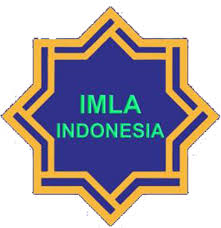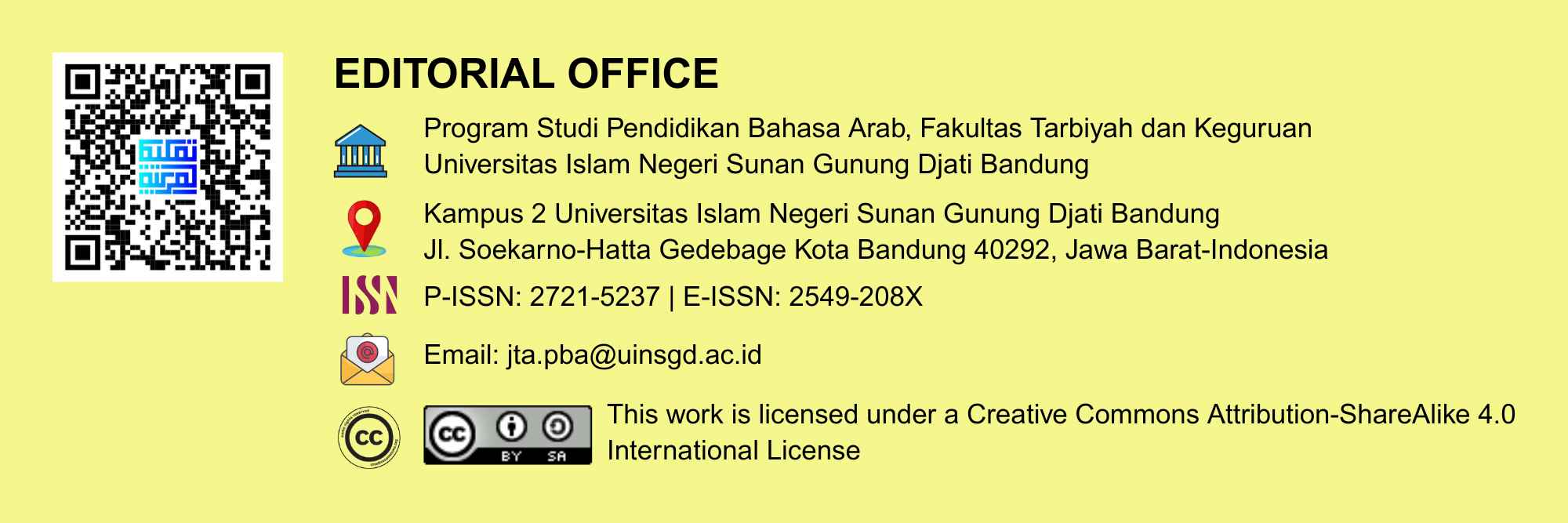Arabic Verbal Gender Agreement Through the Lens of Krashen's Theory of Second Language Acquisition
DOI:
https://doi.org/10.15575/jta.v9i1.44589Keywords:
Arabic language, Second language acquisition, Stephen Krashen, Verbal gender agreementAbstract
Arabic verbal gender agreement poses challenges for second-language learners due to its complexity. This study highlights the necessity for Arabic language programs to implement input at the appropriate level (i+1) and to foster a low-anxiety environment to enhance learner acquisition in line with Krashen's framework. The participants in this study were new students (level 1) with a background in public schools who were still categorized as beginner learners, totaling 29 students. Data collection was conducted through in-depth interviews with 29 participants regarding their experiences in learning and understanding gender agreement, as well as observations to see how the language acquisition process occurs. Then, the data was analyzed using phenomenological thematic analysis. The findings reveal that learners who received comprehensible input at an appropriate level (i+1) demonstrated more accurate responses, suggesting effective language acquisition. In contrast, learners exposed to overly complex input (i+2 or higher) struggled to process the material effectively. Affective factors, such as motivation and anxiety, were also found to influence learning outcomes. High anxiety negatively impacted fluency, while a supportive learning environment enhanced language acquisition. This study highlights the importance of aligning teaching strategies with Krashen's theory, particularly the principle of comprehensible input. It is recommended that Arabic language curricula incorporate materials that gradually increase in difficulty (i+1), ensuring input is both challenging and accessible to learners. This approach can facilitate more effective language acquisition and improve overall student outcomes in Arabic language instruction
References
Alam, M. R., Jahan, S., Khan Milon, M. R., Ansarey, D., & Faruque Al Hadi, S. U. (2021). Accelerating Learners' Self-confidence Level in Second Language Acquisition: A Qualitative Study. ICRRD Quality Index Research Journal, 2(3), 141-153. https://doi.org/10.53272/icrrd.v2i3.5
Albirini, A., Benmamoun, E., & Chakrani, B. (2013). Gender and number agreement in the oral production of Arabic Heritage speakers. Bilingualism, 16(1), 1–18. https://doi.org/10.1017/S1366728912000132
AlSabbagh, Z. A. A. (2023). Grammatical Gender & Linguistic Relativity: Does the Grammatical Gender Native Arabic Speakers Assign Neutral Nouns Affect How They Perceive Them? European Journal of Foreign Language Teaching, 7(1), 69-97. https://doi.org/10.46827/ejfl.v7i1.4673
Alsayat, A., & Elmitwally, N. (2020). A comprehensive study for Arabic Sentiment Analysis (Challenges and Applications). Egyptian Informatics Journal, 21(1), 7–12. https://doi.org/10.1016/j.eij.2019.06.001
Alshammari, A. R. (2023). Analyzing Word Order Variation and Agreement Asymmetry in SVO and VSO Structures of Standard Arabic: Towards a Unified Account. Cogent Arts and Humanities, 10(2), 2268920. https://doi.org/10.1080/23311983.2023.2268920
Anderson, K. (2025). Common Grammatical Challenges for Arabic Language Learners : A Comparative Study of Errors Among Multilingual Speakers. Retrieved from https://www.researchgate.net/profile/Jessie-Anderson-8/publication/388190045_Common_Grammatical_Challenges_for_Arabic_Language_Learners_A_Comparative_Study_of_Errors_Among_Multilingual_Speakers/links/678e692e75d4ab477e511001/Common-Grammatical-Challenges-for-Arabic-Language-Learners-A-Comparative-Study-of-Errors-Among-Multilingual-Speakers.pdf
Baso, Y. S., Murtadho, N., Syihabuddin, Maulani, H., Agussalim, A., Haeruddin, Fadlan, A., & Ramadhan, I. (2023). Reducing Cheating in Online Exams Through the Proctor Test Model The Case of Indonesian Learners of Arabic from the Book of Silsilat Al-Lisan. International Journal of Advanced Computer Science and Applications, 14(1), 366–370. https://doi.org/10.14569/IJACSA.2023.0140139
D'Souza, F. P. (2023). Stephen Krashen's Theory Of Sla: A Conceptual Framework : i-manager's Journal on English Language Teaching, 13(4), 1-12. https://doi.org/10.26634/jelt.13.4.19900
Emiliussen, J., Engelsen, S., Christiansen, R., & Klausen, S. H. (2021). We are all in it!: Phenomenological Qualitative Research and Embeddedness. International Journal of Qualitative Methods, 20, 1–6. https://doi.org/10.1177/1609406921995304
Finlay, L. (2021). Thematic analysis: The "Good”, the “Bad” and the “Ugly.” European Journal for Qualitative Research in Psychotherapy, 11, 103–116. Retrieved from https://ejqrp.org/index.php/ejqrp/article/download/136/93
Firna, R., Ilham, I., Irwandi, I., Rahmania, R., Hidayati, H., & Bafadal, F. (2024). Faktor Penyebab Dampak Kecemasan Berbicara dalam Bahasa Inggris. Seminar Nasional Paedagoria, 4(1), 189-199. Retrieved from https://journal.ummat.ac.id/index.php/fkip/article/view/25619.
Ghafar, Z. . (2023). The Influence of Self-Confidence on English Language Learning: A Systematic Review. International Journal of Applied Educational Research (IJAER), 1(1), 55–68. https://doi.org/10.59890/ijaer.v1i1.452
Guo, R., & Ellis, N. C. (2021). Language Usage and Second Language Morphosyntax: Effects of Availability, Reliability, and Formulaicity. Frontiers in Psychology, 12(1), 582259. https://doi.org/10.3389/fpsyg.2021.582259
Hakim, F. N., & Maulani, H. (2024). Analisis Gradasi Materi Pembahasan Tsulasi Mazid dengan Tambahan Satu Huruf dalam Buku Belajar Tashrif Sistem 40 Jam Karya KH. Aceng Zakaria. Jurnal Edukasi, 2(2), 72–83. https://doi.org/10.60132/edu.v2i2.273
Harrathi, H., Hached, S., Zerai, Z., Khasawneh, M. A. S., & Tashtoush, M. A. (2024). The Effectiveness of Cognitive Activation Strategy in Developing Oral Classical Arabic Communication Competency Among Omani Students’ Courses. Journal of Statistics Applications and Probability, 13(5), 1431–1445. https://doi.org/10.18576/jsap/130502
Huda, M. M., & Irawan, B. (2024). Analysis of Syntactic Errors In Arabic Textbook-Based Instructional Materials And Their Implications for Arabic Learning At Madrasah Aliyah. Ta’lim al-’Arabiyyah: Jurnal Pendidikan Bahasa Arab & Kebahasaaraban, 8(1), 85–102. https://doi.org/10.15575/jpba.v8i1.33580
Luo, Z. (2024). A Review of Krashen's Input Theory. Journal of Education, Humanities and Social Sciences, 26, 130–135. https://doi.org/10.54097/3fnf5786
Majoul, B., Pandya, D., & Wang, L. (Eds.). (2023). Proceedings of the 2022 4th International Conference on Literature, Art and Human Development (ICLAHD 2022). In Proceedings of the 2022 4th International Conference on Literature, Art and Human Development (ICLAHD 2022). Atlantis Press SARL. https://doi.org/10.2991/978-2-494069-97-8
Mashuri, S., Sarib, M., Rasak, A., & Alhabsyi, F. (2022). Semi-structured Interview: A Methodological Reflection on the Development of a Qualitative Research Instrument in Educational Studies Ruslin. IOSR Journal of Research & Method in Education (IOSR-JRME), 12(1), 22–29. https://doi.org/10.9790/7388-1201052229
Maulani, H., & Faqih, A. (2021). Learning Arabic for Beginners: Role-Based Small Group Discussion Cooperative Learning. Tanwir Arabiyyah: Arabic As Foreign Language Journal, 1(2), 83–92. https://doi.org/10.31869/aflj.v1i2.2900
Maulani, H., Muthmainah, N., Khalid, S. M., Saleh, N., & Taufik, I. H. (2024). Investigation of the Reference Level Description for Arabic Proficiency Tests in Indonesia. Jurnal Al Bayan: Jurnal Jurusan Pendidikan Bahasa Arab, 16(1), 1. https://doi.org/10.24042/albayan.v16i1.21566
Muhamad, S., Arista, D., & Rahmayanti, I. (2024). Analisis Linguistik dalam Al-Qur’an (Kajian Morfologi Surah An-Naba’). Al-Mazaya Jurnal Pendidikan Bahasa Arab , 2(1), 41–49. Retrieved from https://jurnal.unupurwokerto.ac.id/index.php/almazaya/index
Pervin, N., & Mokhtar, M. (2023). Reflections on Doing Narrative Inquiry Research: From the Lens of Interpretive Paradigm. The Malaysian Journal of Qualitative Research, 09(01), 49–61. https://doi.org/10.61211/mjqr090104
Salsabila, A., Huda, M. M., & Irawan, B. (2024). Contrastive Analysis of Verbs Seen from Time in Arabic and Madurese. Ethical Lingua: Journal of Language Teaching and Literature, 11(2), 417–425. https://doi.org/10.30605/25409190.733
Seim, J. (2024). Participant Observation, Observant Participation, and Hybrid Ethnography. Sociological Methods and Research, 53(1), 121–152. https://doi.org/10.1177/0049124120986209
Shehata, A. (2024). Learners’ Perceptions of Arabic Consonant Contrasts: Gender and Learning-Context Effects. Languages, 9(3), 1-13. https://doi.org/10.3390/languages9030077
Shoukry, A., & Rafea, A. (2012). Sentence-level Arabic Sentiment Analysis. Proceedings of the 2012 International Conference on Collaboration Technologies and Systems, CTS 2012, 546–550. https://doi.org/10.1109/CTS.2012.6261103
Sovinaz & Rusady, A. (2023). Uncovering Arabic Language Errors In Conversational Context: An Analysis of Derivation and Inflection Aspects. Alsinatuna 8(2), 1–23. https://doi.org/10.28918/alsinatuna.v8i2.1745
Sutisna, D., & Atha, Y. A. S. (2023). Strategies to Increase Interest in Arabic Learning at Senior High School. Ta’lim Al-’Arabiyyah: Jurnal Pendidikan Bahasa Arab & Kebahasaaraban, 7(2), 299–314. https://doi.org/10.15575/jpba.v7i2.23983
Syihabuddin, S., Murtadho, N., Baso, Y. S., Maulani, H., & Khalid, S. M. (2024). The acquisition of nominal gender agreement: praxeology analysis of Arabic second language text book “Silsilah Al-Lisaan.” Journal of Applied Research in Higher Education, 16(4), 1055–1068. https://doi.org/10.1108/JARHE-11-2022-0369
Tucker, M. A., Idrissi, A., & Almeida, D. (2021). Attraction Effects for Verbal Gender and Number Are Similar but Not Identical: Self-Paced Reading Evidence From Modern Standard Arabic. Frontiers in Psychology, 11(1), 586464. https://doi.org/10.3389/fpsyg.2020.586464
Williams, H. (2021). The Meaning of “Phenomenology”: Qualitative and philosophical phenomenological research methods. Qualitative Report, 26(2), 366–385. https://doi.org/10.46743/2160-3715/2021.4587
Yousefabadi, M. M., Ghasemnezhad, T., & Akbarie, Y. (2022). The Effect of Anxiety, Motivation and Self-Confidence in Language Learners’ Reading Proficiency. NeuroQuantology, 20(16), 4966–4976. https://doi.org/10.48047/NQ.2022.20.16.NQ880504
Zibin, A., Allawama, A., Akayleh, M., & Naimat, K. (2024). Investigating Arabic-speaking EFL learners’ understanding of French gender markers: A typological primacy model approach to a third language. Cogent Arts & Humanities, 11(1), 2328898. https://doi.org/10.1080/23311983.2024.2328898
Downloads
Additional Files
Published
How to Cite
Issue
Section
Citation Check
License
Copyright (c) 2025 Hikmah Maulani, Rohanda Rohanda, Mahmud Mahmud, Ashinida Aladdin

This work is licensed under a Creative Commons Attribution-ShareAlike 4.0 International License.
Authors who publish in Ta'lim al-'Arabiyyah: Jurnal Pendidikan Bahasa Arab dan Kebahasaaraban agree to the following terms:
- Authors retain copyright and grant the journal right of first publication with the work simultaneously licensed under a Creative Commons Attribution-ShareAlike 4.0 International (CC BY-SA 4.0) License that allows others to share the work with an acknowledgment of the work's authorship and initial publication in this journal.
- Authors are able to enter into separate, additional contractual arrangements for the non-exclusive distribution of the journal's published version of the work (e.g., post it to an institutional repository or publish it in a book), with an acknowledgment of its initial publication in this journal.
- Authors are permitted and encouraged to post their work online (e.g., in institutional repositories or on their website) prior to and during the submission process, as it can lead to productive exchanges, as well as earlier and greater citation of published work (See The Effect of Open Access).
![]()
Ta'lim al-'Arabiyyah: Jurnal Pendidikan Bahasa Arab dan Kebahasaaraban is licensed under a Creative Commons Attribution-ShareAlike 4.0 International License.
Based on a work at https://journal.uinsgd.ac.id/index.php/Talim







